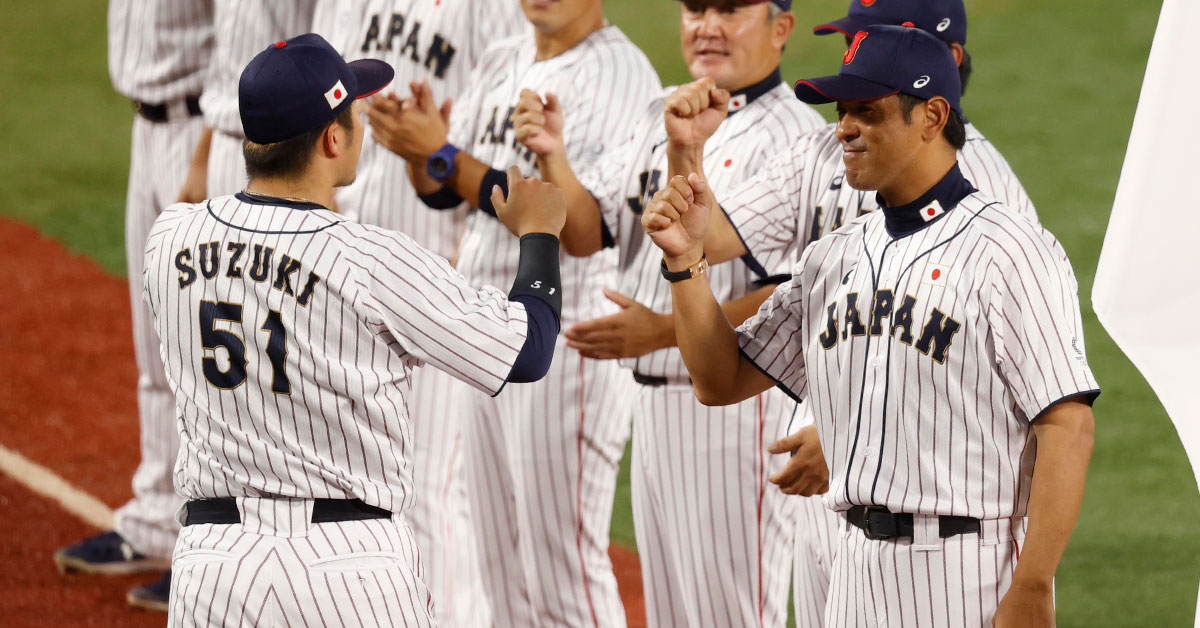It’s Time To Buy Into Cristopher Sánchez
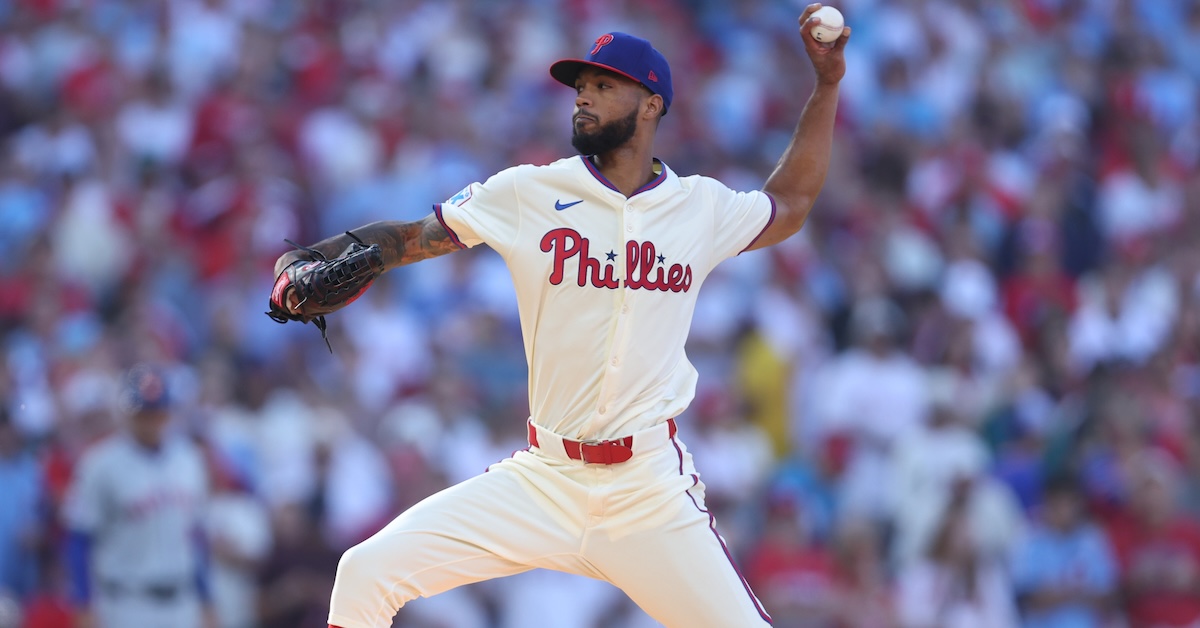
“One for the Money. Two for the Show.” That’s how the saying goes anyways. And that’s how Cristopher Sánchez’s career has gone thus far.
After a stretch of 33 starts from 2023 through mid-June 2024, in which the lanky lefty compiled 183 2/3 innings of a 3.09 ERA, he was really into the money, to the tune of a four-year, $22.5 million extension – with room to grow to six years and $56.5 million with incentives and club options.
He followed up this showing with 15 more strong starts, along with a five-inning performance in Game 2 of the NLDS, the Phillies’ only win against the Mets, to put a bow on his second year as a rising star in the majors.
But why isn’t he treated as such? You won’t often find the 28-year-old gracing MLB’s Instagram account, or even Pitching Ninja’s for that matter. He is not marketed as an ace despite his relative youth, place in a big-market postseason rotation, and proclivity to go deep into games.
Maybe the better question is, why should he be? I’ve decided to take up that mantle, at least within the friendly confines of the FanGraphs Community Blog.
For starters (pun definitely not intended), Sánchez carries a modern ace workload. Across 31 starts in 2024, Sánchez reached 181 2/3 innings. Like a true ace, he faced 24.32 batters per start – for context, this lines up with the volume of notable innings eaters Corbin Burnes and Tarik Skubal, and was certainly in the upper echelon of 2024 starting pitchers.
So, he faced a lot of batters. He also eclipsed 90 pitches per start. Both of these statistics matter because, to an extent, the best ability is availability. Cliché, sure, but true for postseason hopefuls like the Phillies, and true when it comes to staying at the top of fans’ minds. Put differently, Sánchez’s 3.32 ERA was stretched over more innings than most starters in the league threw last season. That is valuable.
Under the hood, the most notable pieces of Sánchez’s profile are his sky-high 39.3% O-Swing% (Sports Info Solutions) and solid 65.8% first pitch strike rate. That 39.3% O-Swing% was good for first in baseball last season. That’s right: Cristopher Sánchez – League Leader. Let that sink in.
As I mentioned earlier, Sánchez is not thought of as a particularly nasty pitcher. His stuff is not commonly GIF’d. He is relatively obscure, as far as sub-3.50 ERA starters on playoff teams go. Yet, he clearly stands out, especially when it comes to generating swings on pitches outside of the zone.
So how does he generate all of this chase? And why aren’t we calling him Chasetopher Sánchez (that may be more obvious)?
Sánchez throws three pitches according to Baseball Savant: sinker (47.3%), changeup (35.7%), and slider (16.9%). And he generally throws them all low in the zone.
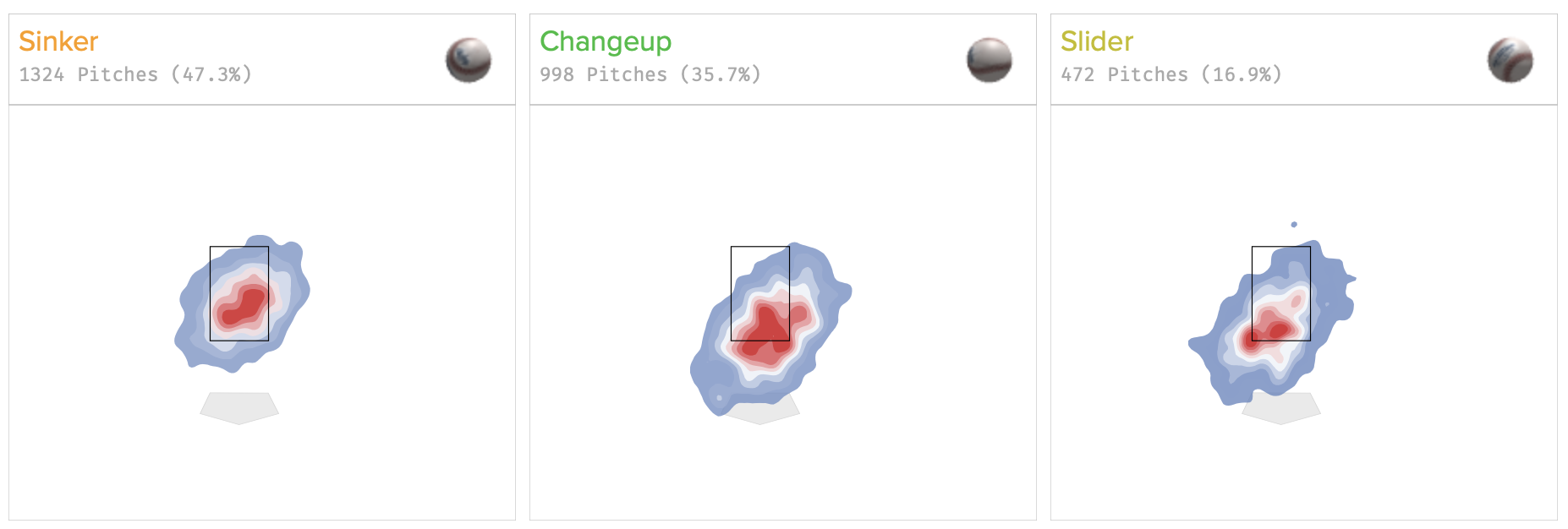
This makes sense. He is a groundball specialist, generating a 58.3% groundball rate last season, good for a 95th percentile finish and the consequent bright red bar on his Savant page. And if we all are trained to do one thing, it’s to love when a player has bright red on his Savant page. It’s akin to a “Happy Hour” sign in a bar window or “BOGO” sign at the deli. It’s the modern day siren song. How could you not follow it?
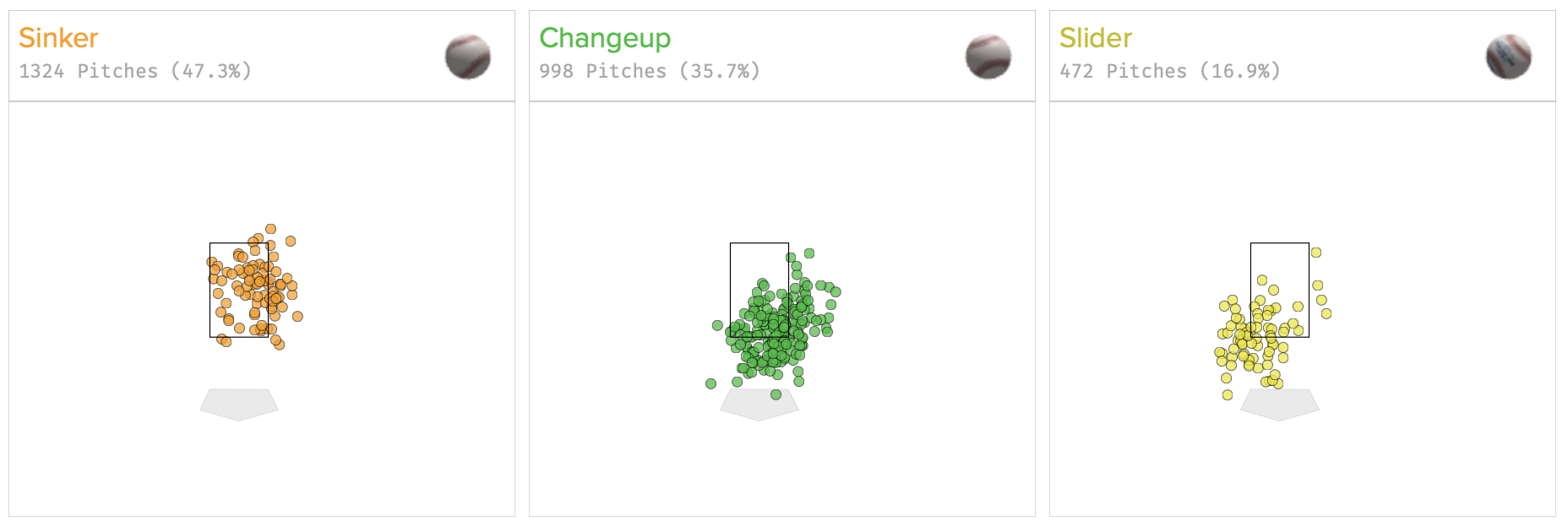
The graphic above shows Sánchez’s three primary pitches and plots only those that generated swings and misses. Clearly, changeups below the zone make up the vast majority of his impressive O-Swing%, followed by sliders below the zone.
Sánchez threw his changeup outside the zone 71.8% of the time last season when ahead in the count (compared to 51.1% of the time when behind) and threw sliders outside the zone 60.4% of the time when ahead. Another note – the changeups in these situations skew glove side, while the sliders skew arm side.
Here was a particularly nice changeup thrown to Freddie Freeman in a 1-1 count.
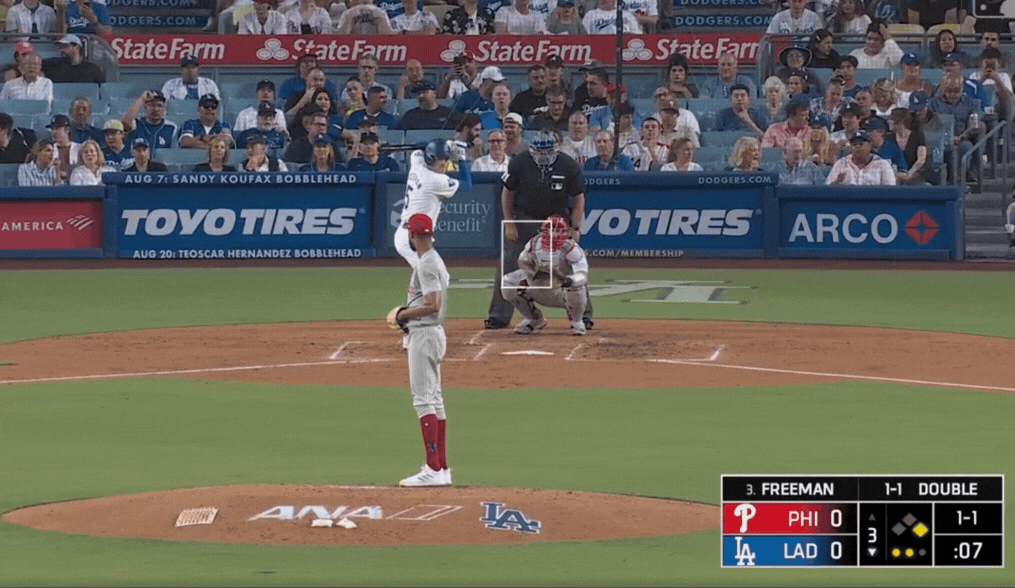
This same pitch and location worked against lefties and righties. See the following string-pull presented to Aaron Judge.
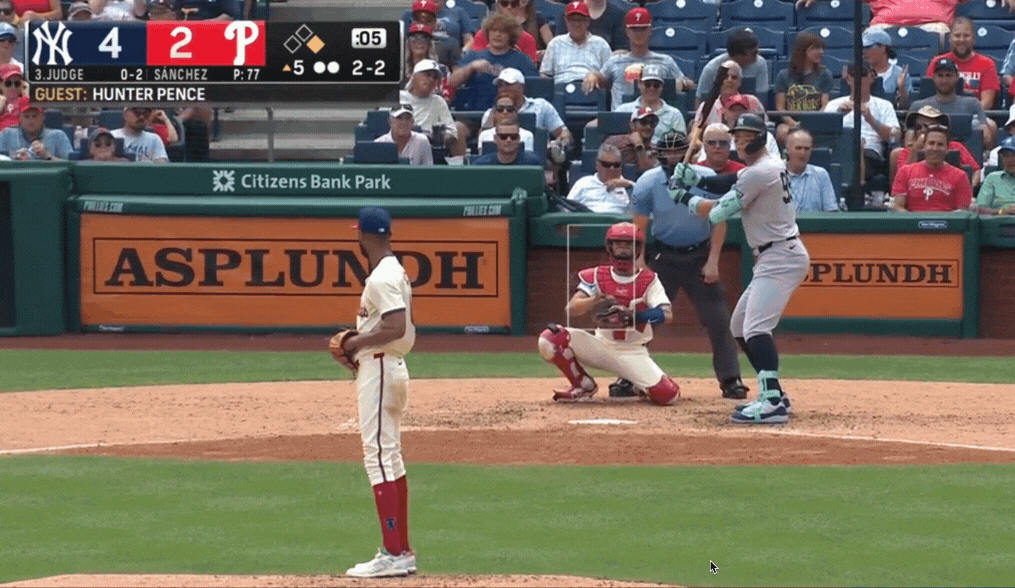
The changeup plays well off of the sinker, his most commonly thrown pitch. There is a nearly 10-mph velocity gap between the two offerings, and both come from the same arm angle and have nearly identical arm-side tail. In other words, this is a nasty pitch, which is borne out in the 18 run value that the pitch generated in 2024, according to Baseball Savant.
Sánchez is elite at generating chase swings, likely because his best pitch is spotted to do just that. But part of why he may not get the consequent publicity his ERA would suggest he deserves is because, even as he gets all those swings on pitches outside the zone, he doesn’t miss as many bats as other high-chase hurlers.
Cubs lefty Shota Imanaga and Twins righty Bailey Ober finished second and third in O-Swing% last season, respectively. Both also allowed less contact on pitches in the zone and generated more swinging strikes than Sánchez. Not surprisingly, thanks to these whiffs, both struck out more batters than Sánchez as well.
| Name | Team | O-Swing% | O-Contact% | Z-Contact% | SwStr% | K% |
|---|---|---|---|---|---|---|
| Cristopher Sánchez | PHI | 39.3% | 67.2% | 86.5% | 11.3% | 20.3% |
| Shota Imanaga | CHC | 38.9% | 60.0% | 83.0% | 14.5% | 25.1% |
| Bailey Ober | MIN | 37.1% | 63.2% | 79.7% | 14.2% | 26.9% |
I think this is, in part, because Imanaga and Ober are fly ball pitchers whereas Sánchez is a ground-and-pound specialist. Famously, balls hit in the air come with a greater risk of going over the fence than grounders, so the best way for Imanaga and Ober to avoid damage is to miss bats. Sánchez, though, can get away with pitching to contact, which can help to keep his pitch count down and allow him to go deeper in games.
| Name | GB% | FB% | HR/9 | K/9 |
|---|---|---|---|---|
| Cristopher Sánchez | 57.4% | 21.5% | 0.54 | 7.58 |
| Shota Imanaga | 37.2% | 45.5% | 1.40 | 9.03 |
| Bailey Ober | 33.5% | 50.3% | 1.36 | 9.62 |
Considering this, the better comparison for Sánchez is another Dominican lefty with an affinity for the sinker: Framber Valdez. Sánchez doesn’t have the pedigree of the Astros ace, but their arsenals and pitching approaches are similar.
| Name | Team | ERA | FIP | GB% | Si% | O-Swing% | SwStr% |
|---|---|---|---|---|---|---|---|
| Cristopher Sánchez | PHI | 3.32 | 3.00 | 57.4% | 47.3% | 39.3% | 11.3% |
| Framber Valdez | HOU | 2.91 | 3.25 | 60.6% | 47.1% | 31.2% | 11.4% |
What’s perhaps even more interesting about this comparison is Valdez’s embrace of the changeup in 2024, as pointed out by Ben Clemens this offseason.
Last season, Valdez threw the changeup in two-strike counts nearly 20% of the time, compared to 13.9% in 2023 and less than 10% of the time in all other prior seasons. Sánchez, meanwhile, threw changeups 51.4% of the time with two strikes last season. This makes plenty of sense, as the pitch generated a healthy 17.8% swinging strike rate.
So perhaps both have something to learn from each other, with Valdez leaning more into the changeup and Sánchez learning from new teammate Jesús Luzardo on his breaking stuff – wouldn’t that be fun? Even more likely, perhaps both are poised to continue frustrating opposing hitters with their bowling ball sinker/change combinations.
Ultimately, for as much love and attention as Valdez has earned at the top of Houston’s rotation, I think it is about time “Chasetopher” catches on and Sánchez gains a bit of respect as an emerging ace.
